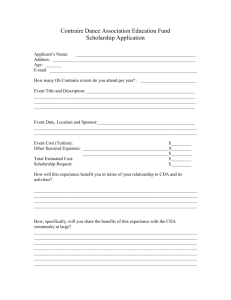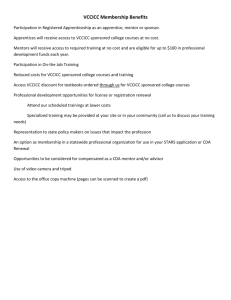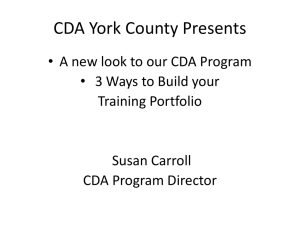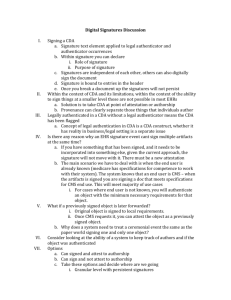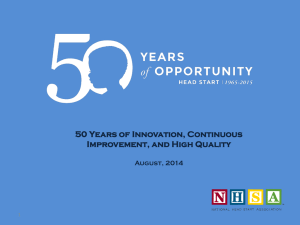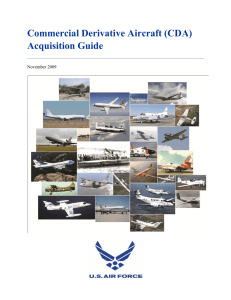notes
advertisement
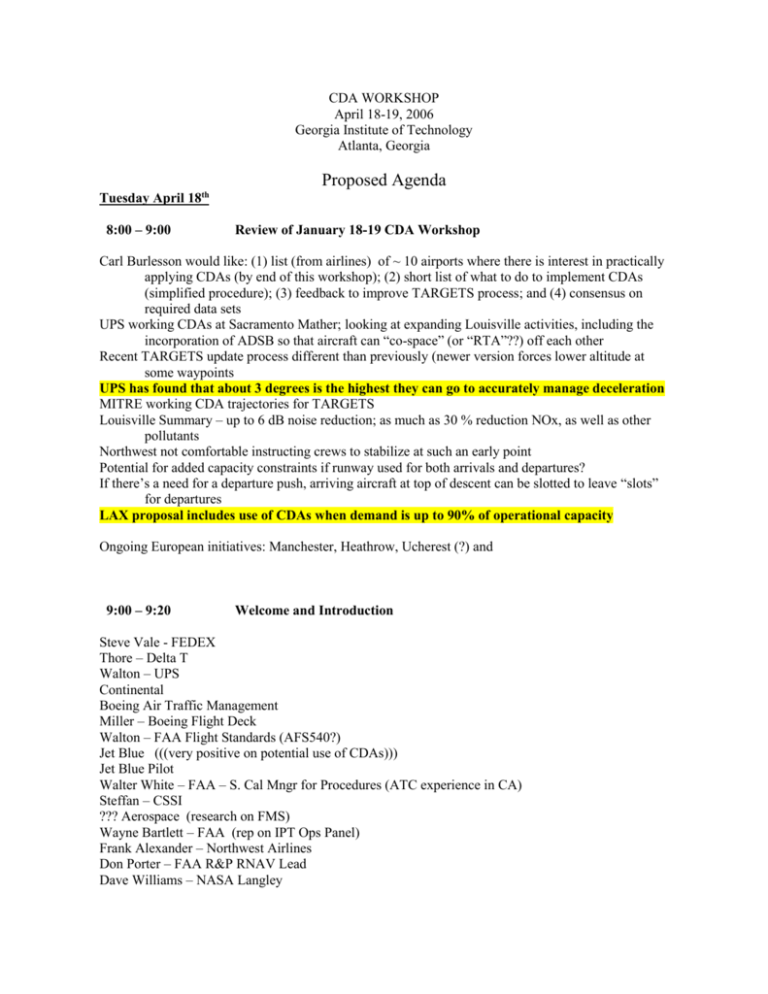
CDA WORKSHOP April 18-19, 2006 Georgia Institute of Technology Atlanta, Georgia Proposed Agenda Tuesday April 18 8:00 – 9:00 th Review of January 18-19 CDA Workshop Carl Burlesson would like: (1) list (from airlines) of ~ 10 airports where there is interest in practically applying CDAs (by end of this workshop); (2) short list of what to do to implement CDAs (simplified procedure); (3) feedback to improve TARGETS process; and (4) consensus on required data sets UPS working CDAs at Sacramento Mather; looking at expanding Louisville activities, including the incorporation of ADSB so that aircraft can “co-space” (or “RTA”??) off each other Recent TARGETS update process different than previously (newer version forces lower altitude at some waypoints UPS has found that about 3 degrees is the highest they can go to accurately manage deceleration MITRE working CDA trajectories for TARGETS Louisville Summary – up to 6 dB noise reduction; as much as 30 % reduction NOx, as well as other pollutants Northwest not comfortable instructing crews to stabilize at such an early point Potential for added capacity constraints if runway used for both arrivals and departures? If there’s a need for a departure push, arriving aircraft at top of descent can be slotted to leave “slots” for departures LAX proposal includes use of CDAs when demand is up to 90% of operational capacity Ongoing European initiatives: Manchester, Heathrow, Ucherest (?) and 9:00 – 9:20 Welcome and Introduction Steve Vale - FEDEX Thore – Delta T Walton – UPS Continental Boeing Air Traffic Management Miller – Boeing Flight Deck Walton – FAA Flight Standards (AFS540?) Jet Blue (((very positive on potential use of CDAs))) Jet Blue Pilot Walter White – FAA – S. Cal Mngr for Procedures (ATC experience in CA) Steffan – CSSI ??? Aerospace (research on FMS) Wayne Bartlett – FAA (rep on IPT Ops Panel) Frank Alexander – Northwest Airlines Don Porter – FAA R&P RNAV Lead Dave Williams – NASA Langley Everet Palmer – NASA Ames Jesse - Boeing Noise Engineering (heavily involved in Amsterdam Schipol CDAs) Pierre – NASA Airspace Management Cavadini – EuroControl vanBoven – Airbus Kim/Roof – Volpe Clarke/Brooks/Garaff? – GTech Liu – FAA AEE Jesse Gaines – FAA Mngr of 9:20 – 9:50 Agenda Review / Meeting Format 9:50 – 10:20 CDA Workshop Goals / Objectives Development of “minimum thrust descent” within appropriate constraints Forum for open exchange between all stakeholders 10:20 – 11:00 (OEP) Discussion - S. Liu Presentation – FAA Operational Evolution Plan Definition: Thrust at/near idle from a high altitude until stabilization point prior to touchdown with no level flight segments Is it appropriate for the Environmental group at FAA to lead this enormous operational effort? Need to ensure that CDA implementation doesn’t “trip and EIS” due to different lateral paths 11:00 – 11:15 Break 11:15 – 11:45 Preliminary Results – Schipol CDA Trial (Boeing) Boeing and LVNL (Dutch ATC) – AAT: Advanced Arrival Techniques 2 airlines: MD11 / 737 / A320 192 CDA flights (others tried but could not) Daytime / nighttime baseline procedures (differing level flight segment altitudes) Results: time about a wash; ~40 to 90 lbm fuel savings (one aircraft type – MD11 savings greater) INM 6 noise results: 1 to 6 dB using FDR data input CDA Demo Results: present individual flight data (noise vs. track distance)? 11:45 – 12:15 Discussion 12:15 – 1:15 Lunch 1:15 – 1:40 CDA Development – Dual Runway IAH (Continental/Boeing) [Kwo-On Tong] (Design concept only) With 3 parallel runways, implement CDA procedures only at 2 so that aircraft not capable of flying CDAs continue uninterrupted FAA 711065P – min. vertical (1,000 feet) or min. radar (3 miles) separation between aircraft on parallel runways 1:40 – 2:10 Discussion 2:10 – 2:30 Example – Successful RNAV STAR Development (FAA/RNAV) – ATO Perspective 7100.9d – Standard Terminal Arrival (STAR) Should be from high altitude down to terminal “Descend Via” - pilot-discretion lateral/vertical navigation (ATC responsible for obstacle clearance ATL CDA benefits analysis (from MITRE) ARTS arrival data 2:30 – 3:00 Discussion 3:00 – 3:15 Break 3:15 – 3:40 Experience Gained – SDF/LAX (SDF/SCT) [Walter White / J.P. Clarke] All carriers at LAX have different flight ops manual Choice of confidence interval on runway end spacing determines monte carlo spacing 30 miles out United / America West – significant up-front work (simulators) 2/23/2006 – “initial implementation” 3/2/2006 – “full implementation” => no flow control needed ¼ of LAX arrival traffic subject to these operations “continuous angle profile” below nominal 3 degree (but loosely parallel) beyond about 25 miles Decision points at ~ 60 and 70 miles from runway end Steps: (1) leave lateral profile; (2) build wind model; (3) use TASAT to determine aircraft-specific crossing altitude at waypoints; and (4) determine best transition altitude Fast-time simulator includes B73/74/75/76 and A319 actual performance Aircraft weight class-specific separations being developed 3:40 – 4:00 Discussion 4:00 – 4:30 Identifying Opportunities for Near-Term Implementation (Georgia Tech) [Todd Waller, Using ASPM - Delta] Delta’s airports of interest: Atlanta, Philadelphia, Newark, Jacksonville, Daytona Beach ???: Buffalo 4:30 – 5:00 Discussion 5:00 Adjourn ----------------------------------------------------------------Wednesday April 19th 9:00 – 9:30 FMS VNAV Capabilities (Sam Miller, Boeing) FMS VNAV boxes contain thousands of performance lookup tables for aircraft/engine combination VNAV & LNAV different yet integrally related VNAV Path constructed from lowest point (on approach) backwards “ECON” descent – least effort to get from here to there Older FMS’ don’t handle multiple angle approach patterns (i.e. stepped 2 to 2.5 to 3 degrees) Is it possible to generate a table of characteristics defining different FMS capabilities/algorithms – only a handful of truly unique (high-level) boxes, but many, many subtle variations Tweaking of VNAV restrictions to optimize flight path and capacity may result in significantly different distances out for top of descent by aircraft type Anti-icing necessitates higher idle thrust on approach 9:30 – 10:00 10:00 – 10:45 Discussion Open Discussion / Air Carrier Coordination [Jim ,UPS] Sacramento Mather Example (“published approach”, not a “special”) Basically extends out published ILS information further in distance/altitude 3-degree approach from 15,000 feet (about 60 miles out) Extension of ILS to 22L Louisville Preferred landing to the North 10:45 – 11:00 Break 11:00 – 11:20 Data Requirements – Pre & Post CDA [Brooks] Near term: Per FAA Administrator: wants 5 airports doing CDA demos by end of 2006 Need to document environmental benefits Carriers will need to have documented $$ savings in advance of procuring required FMS/other electronics FOQA / ACARS / FDR / radar data Pre/post fuel flow / emissions calculations Support structure needed across carriers to do items above and document benefits to Washington Data Requirements – Pre & Post CDA [Brooks] 11:20 – 11:45 Discussion 11:45 – 1:00 Lunch 1:00 – 2:00 Group Specific / Breakout or Discussion 2:00 – 2:20 RNAV Departure 2:20 – 2:40 Discussion 2:40 – 3:00 Break 3:00 – 4:00 Wrap-up Next meeting: some time in last 2 weeks of July Topics for next time: More air carrier support needed for future CDA workshops Need for Airbus performance expert More specifics on design philosophies for FMS designs Smiths Honeywell Comparison of FMS algorithms Influence of Cost Index Specific example of the development of a single CDA procedure Interaction of arrivals and departures Presentation of controller’s perspective (workload / running traffic) Other airline specific cases/experiences Invite MITRE? Distinction between current capabilities and longer term NGATS capabilities Will B787 / A380 blow current procedures out of the water? 4:00 Adjourn “CDAA” – CDA Anonymous support group
